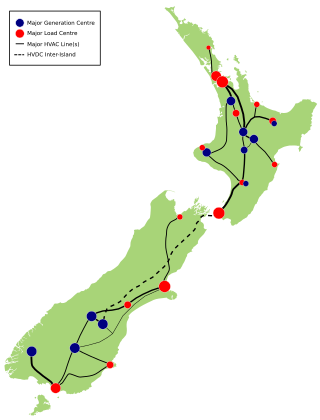Related Research Articles

In electrical engineering, ground or earth may be a reference point in an electrical circuit from which voltages are measured, a common return path for electric current, or a direct physical connection to the Earth.

A substation is a part of an electrical generation, transmission, and distribution system. Substations transform voltage from high to low, or the reverse, or perform any of several other important functions. Between the generating station and consumer, electric power may flow through several substations at different voltage levels. A substation may include transformers to change voltage levels between high transmission voltages and lower distribution voltages, or at the interconnection of two different transmission voltages. They are a common component of the infrastructure. There are 55,000 substations in the United States.

The Baltic Cable is a monopolar HVDC power line running beneath the Baltic Sea that interconnects the electric power grids of Germany and Sweden. Its maximum transmission power is 600 megawatts (MW).

An HVDC converter station is a specialised type of substation which forms the terminal equipment for a high-voltage direct current (HVDC) transmission line. It converts direct current to alternating current or the reverse. In addition to the converter, the station usually contains:

A lineworker constructs and maintains the electric transmission and distribution facilities that deliver electrical energy to industrial, commercial, and residential establishments. A lineworker installs, services, and emergency repairs electrical lines in the case of lightning, wind, ice storm, or ground disruptions. Whereas lineworkers generally work at outdoor installations, those who install and maintain electrical wiring inside buildings are electricians.
The New York Power Authority (NYPA), officially the Power Authority of the State of New York, is a New York State public-benefit corporation. It is the largest state public power utility in the United States providing some of the lowest-cost electricity in the nation, operating 16 generating facilities and more than 1,400 circuit-miles of transmission lines. Its main administrative offices are in White Plains, New York

In electrical engineering, a synchronous condenser is a DC-excited synchronous motor, whose shaft is not connected to anything but spins freely. Its purpose is not to convert electric power to mechanical power or vice versa, but to adjust conditions on the electric power transmission grid. Its field is controlled by a voltage regulator to either generate or absorb reactive power as needed to adjust the grid's voltage, or to improve power factor. The condenser’s installation and operation are identical to large electric motors and generators.

In electronics, a decoupling capacitor is a capacitor used to decouple one part of a circuit from another. Noise caused by other circuit elements is shunted through the capacitor, reducing its effect on the rest of the circuit. For higher frequencies, an alternative name is bypass capacitor as it is used to bypass the power supply or other high-impedance component of a circuit.

ITC Holdings Corporation is an American energy company which owns and operates high-voltage electricity transmission networks. Headquartered in Novi, Michigan, ITC has operations in Michigan, Illinois, Iowa, Kansas, Minnesota, Missouri, Oklahoma, and Wisconsin. The company is a wholly-owned subsidiary of Canadian energy company Fortis Inc.

Hydro-Québec's electricity transmission system is an international electric power transmission system centred in Quebec, Canada. The system pioneered the use of very high voltage 735-kilovolt (kV) alternating current (AC) power lines that link the population centres of Montreal and Quebec City to distant hydroelectric power stations like the Daniel-Johnson Dam and the James Bay Project in northwestern Quebec and the Churchill Falls Generating Station in Labrador.

GKK Etzenricht, an abbreviation of Gleichstromkurzkupplung Etzenricht, meaning Etzenricht HVDC-back-to-back station, was an HVDC back-to-back facility near Etzenricht in the district of Neustadt an der Waldnaab in Bavaria, Germany. It was built on the site of the Etzenricht substation, a 380 kV/220 kV/110 kV-substation, which went into service in 1970 and expanded afterwards several times. The facility was used between 1993 and 1995 for the exchange of power between Germany and the Czech Republic, operated by Bayernwerk AG.

The GK Dürnrohr was a high-voltage direct current back-to-back scheme west of Dürnrohr substation, which was used for the energy exchange between Austria and Czechoslovakia between 1983 and 1996. The installation is no longer in use.

Amtrak's 25 Hz traction power system is a traction power network for the southern portion of the Northeast Corridor (NEC), the Keystone Corridor, and several branch lines between New York City and Washington D.C. The system was constructed by the Pennsylvania Railroad between 1915 and 1938 before the North American power transmission grid was fully established. This is the reason the system uses 25 Hz, as opposed to 60 Hz, which is the standard for power transmission in North America. In 1976, Amtrak inherited the system from Penn Central, the successor to the Pennsylvania Railroad, along with the rest of the NEC infrastructure.

Capacitors have many uses in electronic and electrical systems. They are so ubiquitous that it is rare that an electrical product does not include at least one for some purpose. Capacitors allow only AC signals to pass when they are charged blocking DC signals. The main components of filters are capacitors. Capacitors have the ability to connect one circuit segment to another. Capacitors are used by Dynamic Random Access Memory (DRAM) devices to represent binary information as bits.

The National Grid is the nationwide system of electric power transmission in New Zealand. The grid is owned, operated and maintained by Transpower New Zealand, a state-owned enterprise, although some lines are owned by local distribution companies and leased to Transpower. In total, the national grid contains 11,803 kilometres (7,334 mi) of high-voltage lines and 178 substations.

Amtrak operates a 60 Hz traction power system along the Northeast Corridor between New Haven, Connecticut, and Boston, Massachusetts. This system was built in the late 1990s and supplies locomotives with power from an overhead catenary system at 25 kV alternating current with a frequency of 60 Hz. The system is also commonly known as the Northend Electrification, in contrast to the Southend Electrification that runs between New York City and Washington, D.C.
The Isinya–Singida High Voltage Power Line is a high voltage electricity power line, under construction, connecting the high voltage substation at Isinya, Kenya to another high voltage substation at Singida, Tanzania.
The Transmission Owner Transmission Solutions (TOTS) was a group of three electric power bulk transmission projects constructed on the New York bulk transmission system to increase transfer capability between Upstate New York and Downstate New York. The projects were in-service by June 2016. The projects were proposed by a consortium of the state's seven Investor-Owned Utility (IOU) companies in response to a New York State Public Service Commission (NYSPSC) appeal for Indian Point contingency plans in the event that the 2,060-MW Indian Point power facility were to retire. The shutdown of the Indian Point facility has been a policy goal of Governor Andrew Cuomo since before he began his administration in New York in 2011. The TOTS projects are estimated to have costed $240 million to construct. Construction costs were divided between the seven Transco utilities and the New York Power Authority (NYPA). The IOUs are receiving a 10% return on equity for construction of the projects which is being recovered through retail consumer rates approved by the NYSPSC.
The Mbale–Bulambuli–Siti Medium Voltage Power Line is a medium voltage electricity power line (33kV), under construction, connecting the medium voltage substation at Siti II Hydroelectric Power Station in Bukwo District, in the Eastern Region of Uganda, to another medium voltage substation in the city of Mbale, the largest urban centre in Uganda's Eastern Region.
The Galafi–Nagad High Voltage Power Line, is a 230 kV double circuit high-voltage electricity power transmission line that is planned to connect the high voltage substation at Galafi, Djibouti to another high voltage substation at Nagad, Djibouti. The power project also involves the strengthening of the high voltage transmission line between Samera, Ethiopia and Galafi, Djibouti to augment that part of the Ethiopian grid and minimize the possibility of "isolation of the Djibouti national grid" and end of circuit issues in Nagad. This interconnection between the national grids of Ethiopia and Djibouti, is the second, the first one having been established in 2011.
References
- 1 2 "Archived copy". Archived from the original on December 25, 2014. Retrieved June 2, 2017.
{{cite web}}: CS1 maint: archived copy as title (link) - ↑ "NYPA COMPLETES ELECTRIC GRID PROJECT TO IMPROVE RELIABILITY AND BRING MORE RENEWABLE ENERGY DOWNSTATE". nypa.gov. nypa. 2016. Retrieved September 22, 2017.
data